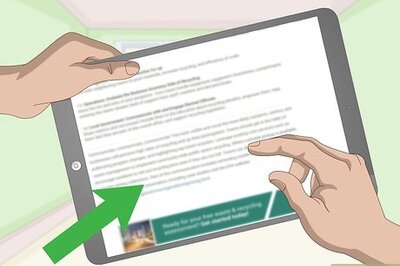
views
As the internet has changed the country’s economy in myriad ways over the last couple of decades, its penetration in India has been found to be the lowest among the developing markets, a survey found.
According to a 2017 global survey by the Pew Research Centre, only one in four Indian adults report using the Internet or owning a smartphone.
Internet access is so vital that in 2016 the United Nations passed a nonbinding resolution to make disruption of Internet access a violation of human rights. While the governments and companies all over the world are working towards increasing Internet access, India finds itself at the bottom of the 39 large economies considered in the survey of over 44,000 adults.
This global digital divide is largely an economic story. Richer countries, as measured by gross domestic product per capita (purchasing power parity), tend to have higher rates of Internet use, while poorer countries tend to have lower rates.
Mobile phones, like the Internet, play an important role in modern society. And in poorer countries where fixed Internet use is not as widespread, mobile phones can be extremely important tools.
However, despite the booming economy, India’s progress in smartphone penetration has been slow. In 12 of the 22 emerging and developing nations surveyed, fewer than 50 per cent report owning a smartphone.
And in India and Tanzania, less than one-quarter report owning smartphones, the lowest among the countries surveyed. This slow adoption of smartphones in India has hampered the growth of the internet in the country since most Indians tend to access the internet on their mobiles.

Across the countries surveyed, young people (18–36 years) are more likely than older generations to use the internet. Similar is the case with India, where 35 per cent young people access internet against 13 per cent of middle-aged and old men (35+ years). However, even that number is pretty low.
Similarly, education is also a dividing factor in internet use, with significant gaps between those with more and less education in all countries surveyed. In India, the difference stood at 42 per cent.
Social media use has also increased in the emerging markets. More than 50 per cent of the adults in developing countries use social sites like Facebook, Instagram, and Twitter. But despite all the hullabaloo, only a quarter of Indian adults are on social media.

Cyber Attacks
With the digitisation of critical government databases, the risk of digital thefts — from personal information to financial data to biometric details — is looming large on India.
A recently published Internet Security Threat Profile report by security solutions provider Symantec put India as the third most vulnerable country in terms of risk of cyber threats, such as malware, spam and ransomware.
India moved up one place from last year and continues to be the second most impacted by spam and bots, third most impacted by network attacks, and fourth most impacted by ransomware.
Another report by Cloud delivery network provider Akamai Technologies published in April this year found India to be the fourth most targeted country for Web Application Attacks as bot-driven abuse and distributed denial of service (DDoS) attacks continued to rise since November 2017.
In 2016, 3.2 million credit card and debit card details were stolen by Chinese hackers. The Food and Civil Supplies Department of Chandigarh had reportedly published Aadhaar numbers of their public distribution system beneficiaries in April last year. A couple and one month later, the Jharkhand Directorate of Social Security had reported a similar leak.
World Bank’s 2017 global findex database put India as the leader among the 10 largest emerging markets in the world as the country had the highest share of people with an account in a financial institution (or mobile money provider). However, the same survey noted that nearly half of those account-holders don’t use those accounts making India also the country with the highest share of inactive accounts.

















Comments
0 comment